The accreditors of this session require that you periodically check in to verify that you are still attentive. Please click the button below to indicate that you are.
1129
COMPARATIVE ANALYSIS OF LONDON CLASSIFICATION AND CONVENTIONAL MEASURES ON HIGH-RESOLUTION ANORECTAL MANOMETRY IN PREDICTING PATIENT-REPORTED HINDGUT SYMPTOM OUTCOMES
Date
May 9, 2023
Explore related products in the following collection:
Society: AGA
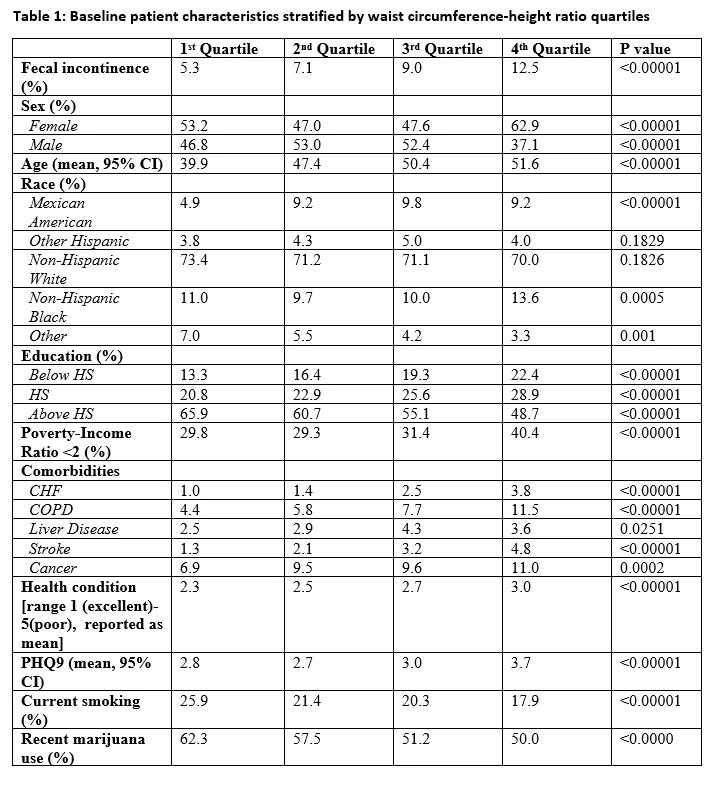
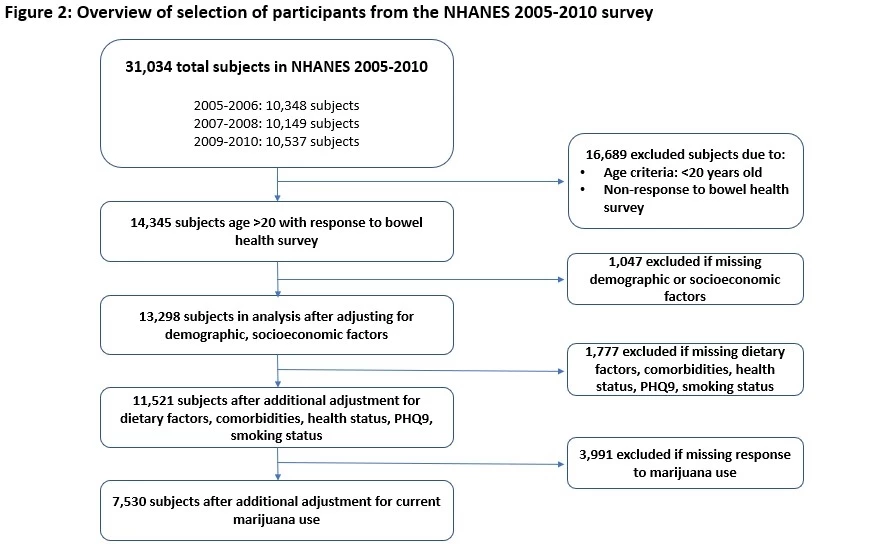
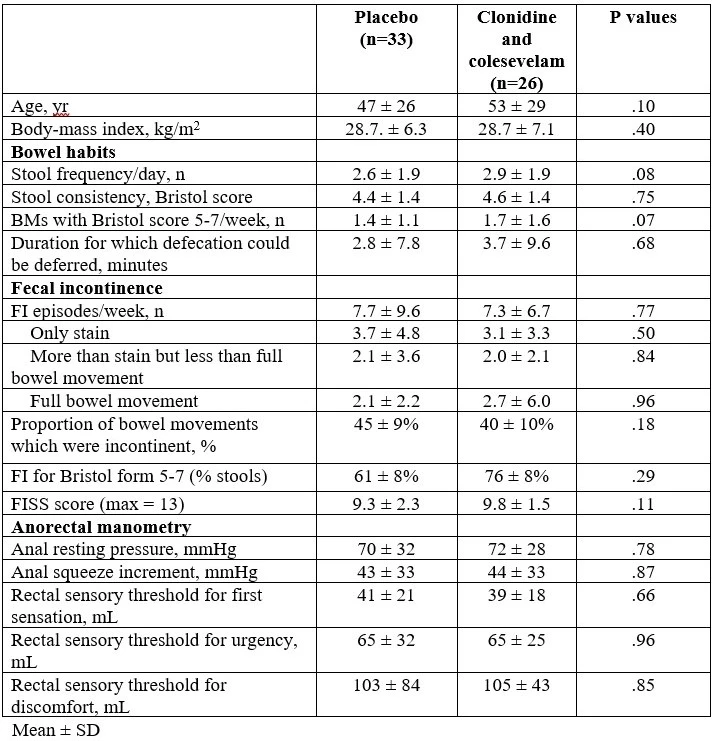

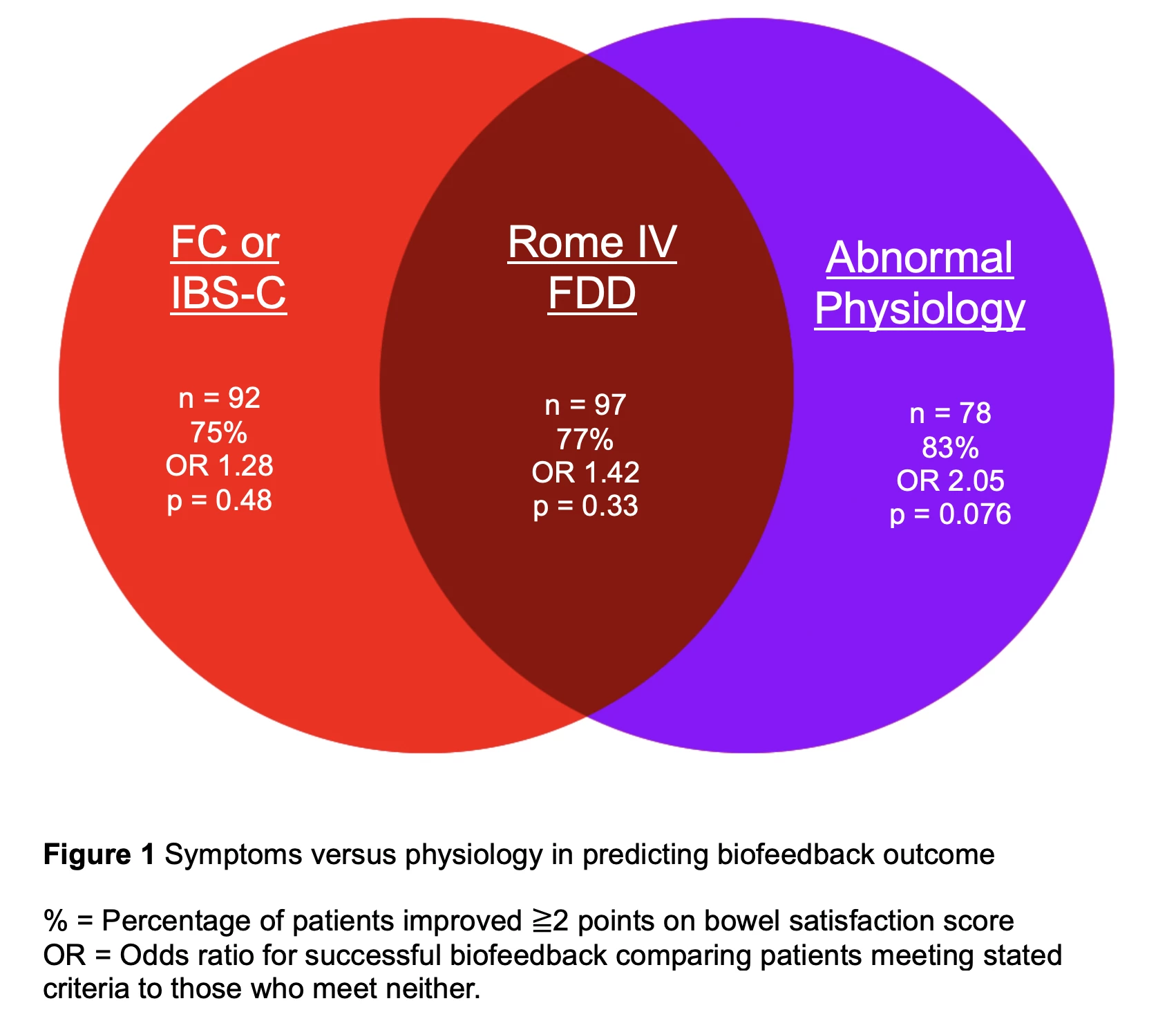

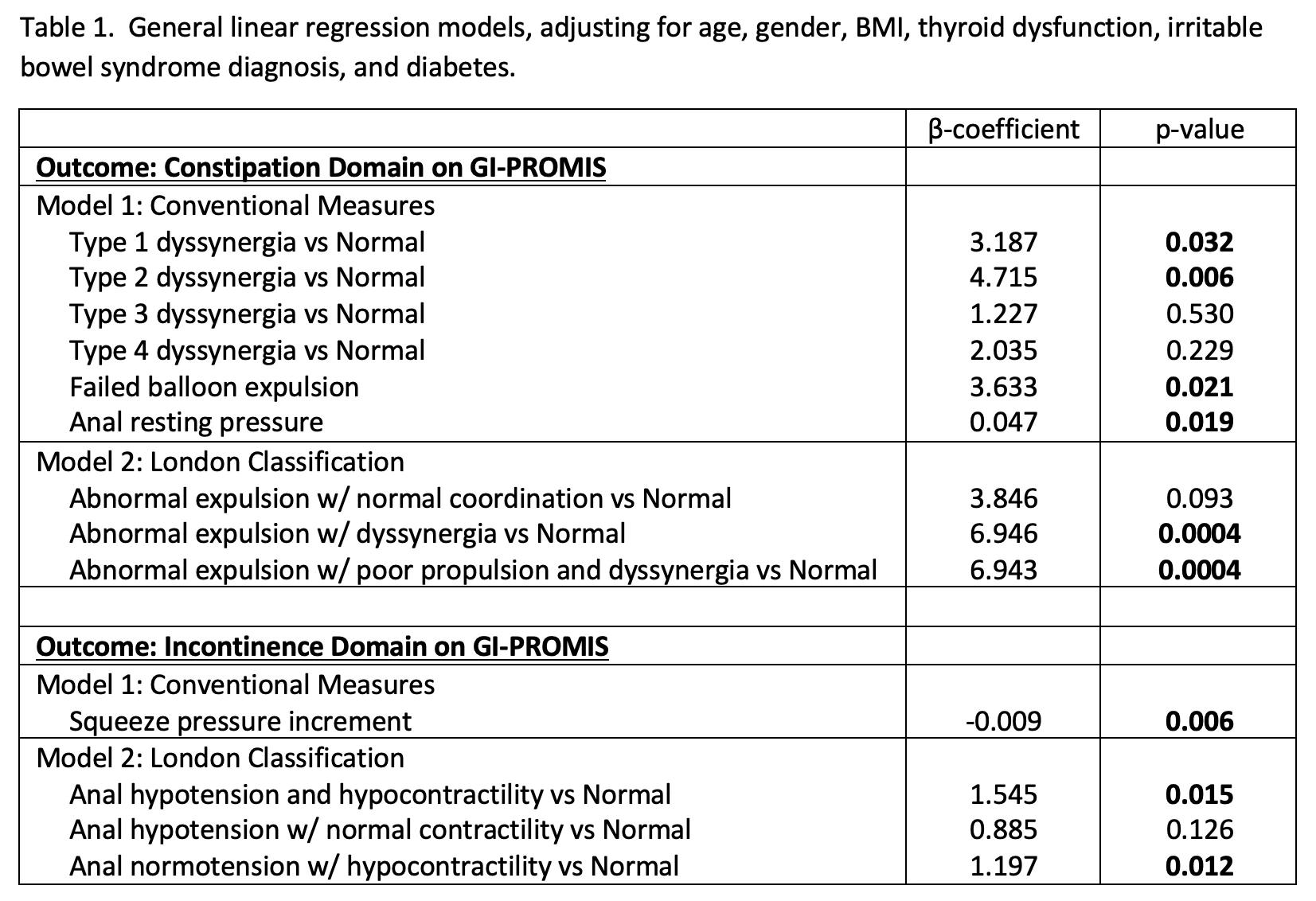
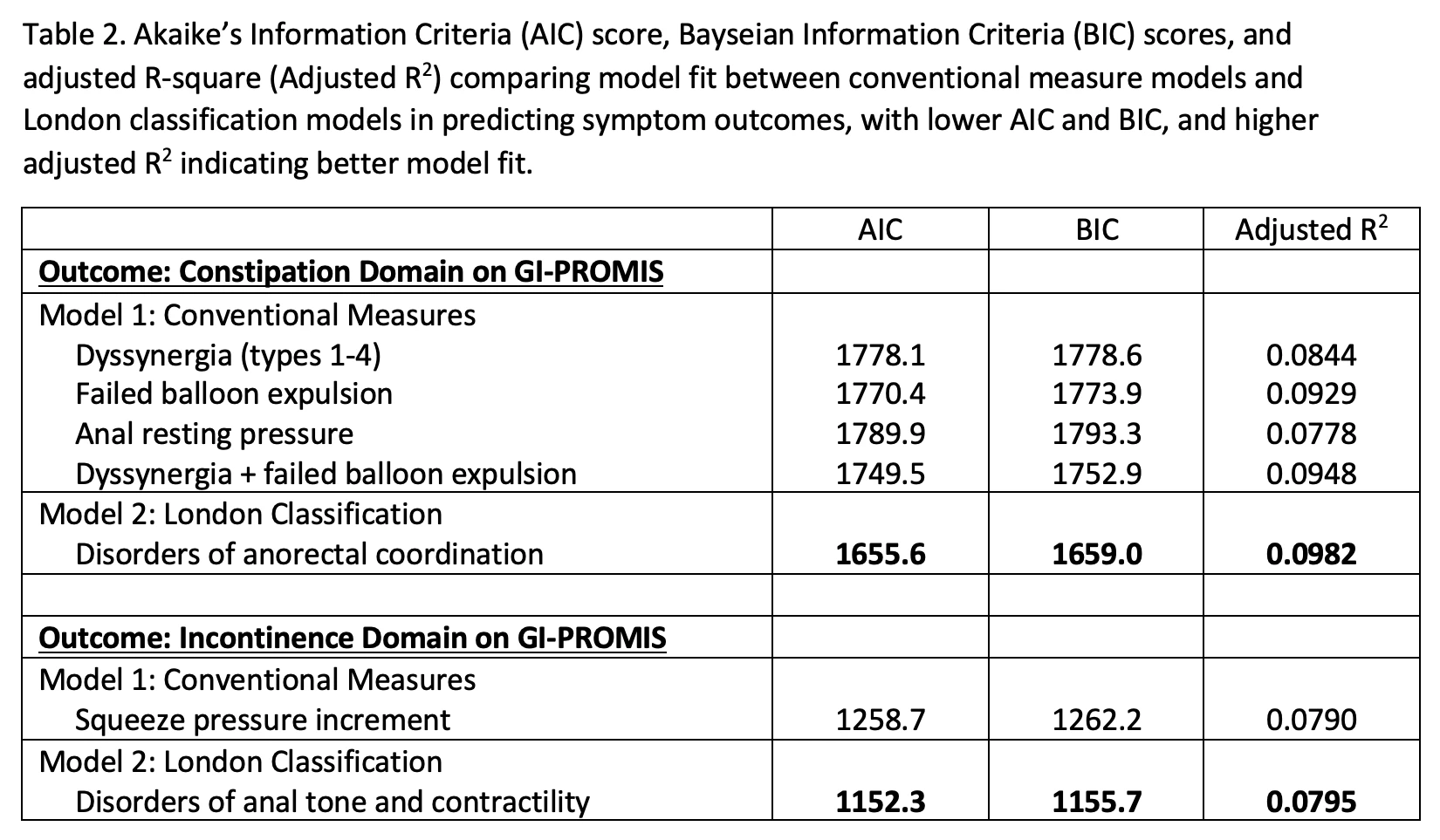
Introduction:
Fecal incontinence is associated with substantial impacts on quality of life. Prevalence estimates range from 2% to as high as 20% based on the methodology used, and is likely underreported by patients. Prior studies have demonstrated inconsistent effects of body-mass index on fecal incontinence. This study sought to further clarify the impact of modifiable measured physical indices of body mass on fecal incontinence in a nationally representative cross-sectional cohort of participants.
Methods:
This study analyzed the National Health and Nutrition Examination Survey (NHANES), an annual cross-sectional, nationally representative health survey. Surveys collected between 2005-2010 included survey components assessing bowel health. Fecal incontinence was defined by accidental bowel leakage of solid stool, liquid, or mucus at least once in the past month. Sample weight adjustment was performed to account for complex survey design. Stepwise multivariate logistic regression models were constructed to assess risk factors for fecal incontinence.
Results:
14,345 participants were identified with responses to the bowel health survey. After stepwise adjustment for covariates (including demographics, comorbidities, dietary factors, socioeconomic factors, depression scores, diarrhea, marijuana use, Figure 1), 7,530 participants were included in the final multivariate model (Figure 2). Waist circumference-height ratio was a significant predictor of fecal incontinence (OR 1.73, 95% CI 1.04-2.88, p=0.036) comparing the 4th to the 1st quartile of values. Quartiles of BMI, conversely, did not significantly predict fecal incontinence.
Conclusions:
Waist circumference-height ratio is a significant risk factor for fecal incontinence. While waist-circumference-height ratio predicted fecal incontinence, body-mass index did not. This suggests bowel continence depends on how body mass is distributed. Further study of the role of central deposition of body mass in neuromuscular control of bowel continence is warranted.
Fecal incontinence is associated with substantial impacts on quality of life. Prevalence estimates range from 2% to as high as 20% based on the methodology used, and is likely underreported by patients. Prior studies have demonstrated inconsistent effects of body-mass index on fecal incontinence. This study sought to further clarify the impact of modifiable measured physical indices of body mass on fecal incontinence in a nationally representative cross-sectional cohort of participants.
Methods:
This study analyzed the National Health and Nutrition Examination Survey (NHANES), an annual cross-sectional, nationally representative health survey. Surveys collected between 2005-2010 included survey components assessing bowel health. Fecal incontinence was defined by accidental bowel leakage of solid stool, liquid, or mucus at least once in the past month. Sample weight adjustment was performed to account for complex survey design. Stepwise multivariate logistic regression models were constructed to assess risk factors for fecal incontinence.
Results:
14,345 participants were identified with responses to the bowel health survey. After stepwise adjustment for covariates (including demographics, comorbidities, dietary factors, socioeconomic factors, depression scores, diarrhea, marijuana use, Figure 1), 7,530 participants were included in the final multivariate model (Figure 2). Waist circumference-height ratio was a significant predictor of fecal incontinence (OR 1.73, 95% CI 1.04-2.88, p=0.036) comparing the 4th to the 1st quartile of values. Quartiles of BMI, conversely, did not significantly predict fecal incontinence.
Conclusions:
Waist circumference-height ratio is a significant risk factor for fecal incontinence. While waist-circumference-height ratio predicted fecal incontinence, body-mass index did not. This suggests bowel continence depends on how body mass is distributed. Further study of the role of central deposition of body mass in neuromuscular control of bowel continence is warranted.


BACKGROUND. Some women with urge-predominant fecal incontinence (FI) have a stiffer rectum and rectal hypersensitivity. In a phase 2 study, the a2 adrenergic agonist clonidine, which increases rectal compliance and reduces rectal sensation, did not reduce FI in all women with urge FI, but had borderline significant effects in women with diarrhea and urge FI. Up to 25% of patients with idiopathic diarrhea have bile acid malabsorption, which may respond to bile acid sequestrants. HYPOTHESES. Clonidine and colesevelam (CC) will improve fecal continence in women with urge FI. METHODS. Symptoms were recorded for 2-4 weeks before and 4 weeks during randomization to placebo or oral clonidine 0.1mg bid and colesevelam 625 mg tid in 59 women with urge-predominant FI who did not have an organic GI disorder. Bowel symptoms (daily diaries and other questionnaires), anal pressures, and rectal sensation were assessed. The last 2 wks of the baseline period and weeks 2-4 of treatment phase were analyzed. Fecal Incontinence Symptom Severity (FISS) score, fecal incontinence severity index (FISI) and FISI-QoL were computed pre- and during treatment. For the primary outcome (number of FI episodes), missing data were conservatively imputed using the average for all participants. RESULTS. At baseline, placebo and CC groups were not different (Table 1); on average patients had moderately severe FI. After the baseline phase, 3, 1 and 51 patients respectively completed 1, 2, and 4 wks of therapy; 1 eligible patient did not begin therapy and 3 patients were not eligible to receive therapy. Several measures of FI (number of episodes of FI, satisfaction with treatment) improved with placebo (Table 2). The primary outcome (≥50% reduction in FI episodes) was not different between CC (13/24 [54%]) and placebo (17/32 [53%]). Compared to placebo, CC improved the FISS but not other bowel symptoms. Among 21 and 30 patients who completed 4 wks of CC and placebo, the change (treatment – baseline) in FI episodes during therapy was directly correlated with the rectal urge sensory threshold (rs= 0.50, P =.03) in the CC but not in the placebo group (rs= 0.17, P =.34). CONCLUSION. In this controlled study, 53% of patients treated with placebo reported a >50% reduction in the number of FI episodes; for this outcome, effects of CC were not significant vs placebo. But, CC did improve the FISS score, which incorporates frequency, type, and amount of leakage and rectal urgency vs placebo. CC but not placebo was more effective in pts with a higher rectal sensory threshold volume for urgency, which suggests that is more likely to be effective in pts without rectal hypersensitivity. Future controlled trials should evaluate the utility of CC in patients who have documented bile acid malabsorption.

Table 1. Baseline Characteristics

Table 2. Primary, Secondary and Additional End Points
Background: Controversy exists regarding the optimum diagnostic criteria for a defecatory disorder. The commonly employed Rome definition utilises symptoms (functional constipation (FC) or constipation predominant irritable bowel syndrome (IBS-C)) plus disordered defecatory physiology to diagnose a functional defecation disorder (FDD). Biofeedback is the gold standard treatment for FDD and response to biofeedback could therefore be used to assess the validity of the current Rome IV diagnostic criteria.
Aim: To compare the outcome of biofeedback therapy in patients with a formal Rome IV FDD diagnosis to a group of patients presenting with defecatory symptoms who, for various reasons, do not meet Rome criteria.
Method: 380 consecutive patients (mean age 50yrs, 348F) presenting to a tertiary referral clinic with defecatory symptoms who underwent biofeedback therapy between 2003-2019 were included. Prospectively collected data included Rome and Knowles constipation questionnaires, structured clinical interview, anorectal manometry, sensation testing, and balloon expulsion. Two or more point improvement in patient-reported bowel satisfaction visual analog score was used as the main outcome. Six symptoms (stool consistency, time spent in toilet, sense of blockage during defecation, sense of incomplete emptying, digitation and abdominal pain preceding altered bowel movements) were evaluated for their utility in identifying successful biofeedback therapy using backward stepwise logistic regression.
Results: 76% of all patients reported two or more point improvement in bowel satisfaction on completion of biofeedback. There was no significant difference in biofeedback outcome between patients who met Rome FDD compared to those who did not (p=0.33). There was also no difference between those who met Rome FC or IBS-C and those that did not in terms of biofeedback outcome (p=0.48). However, having two or more abnormal physiology measures showed a trend towards better prediction of biofeedback outcome compared to those with more normal physiology (p=0.076; Figure 1). Digitation during defecation and abdominal pain preceding abnormal bowel movements were the only variables independently associated with biofeedback outcome on regression analysis (p=0.014, p=0.041 respectively; Table 1).
Conclusion: Despite current recommendations, a Rome IV diagnosis of FDD was no better at predicting better biofeedback outcome than patients referred with defecatory symptoms that did not meet Rome criteria. Physiology criteria appeared better than FC or IBS-C criteria in predicting biofeedback outcome. Other defecatory symptoms, especially digitation and abdominal pain with altered bowel movements, show promise to be combined with abnormal physiology to predict outcome of biofeedback. These results should be considered in further refinement of Rome diagnostic criteria for FDD.
Aim: To compare the outcome of biofeedback therapy in patients with a formal Rome IV FDD diagnosis to a group of patients presenting with defecatory symptoms who, for various reasons, do not meet Rome criteria.
Method: 380 consecutive patients (mean age 50yrs, 348F) presenting to a tertiary referral clinic with defecatory symptoms who underwent biofeedback therapy between 2003-2019 were included. Prospectively collected data included Rome and Knowles constipation questionnaires, structured clinical interview, anorectal manometry, sensation testing, and balloon expulsion. Two or more point improvement in patient-reported bowel satisfaction visual analog score was used as the main outcome. Six symptoms (stool consistency, time spent in toilet, sense of blockage during defecation, sense of incomplete emptying, digitation and abdominal pain preceding altered bowel movements) were evaluated for their utility in identifying successful biofeedback therapy using backward stepwise logistic regression.
Results: 76% of all patients reported two or more point improvement in bowel satisfaction on completion of biofeedback. There was no significant difference in biofeedback outcome between patients who met Rome FDD compared to those who did not (p=0.33). There was also no difference between those who met Rome FC or IBS-C and those that did not in terms of biofeedback outcome (p=0.48). However, having two or more abnormal physiology measures showed a trend towards better prediction of biofeedback outcome compared to those with more normal physiology (p=0.076; Figure 1). Digitation during defecation and abdominal pain preceding abnormal bowel movements were the only variables independently associated with biofeedback outcome on regression analysis (p=0.014, p=0.041 respectively; Table 1).
Conclusion: Despite current recommendations, a Rome IV diagnosis of FDD was no better at predicting better biofeedback outcome than patients referred with defecatory symptoms that did not meet Rome criteria. Physiology criteria appeared better than FC or IBS-C criteria in predicting biofeedback outcome. Other defecatory symptoms, especially digitation and abdominal pain with altered bowel movements, show promise to be combined with abnormal physiology to predict outcome of biofeedback. These results should be considered in further refinement of Rome diagnostic criteria for FDD.


Introduction: High resolution anorectal manometry (HRAM) is an important tool in assessing anorectal dysfunction. The recent International Anorectal Physiology Working Group protocol and London classification (LC) proposed standardized criteria for performing and interpreting HRAM. However, comparative data on LC versus conventional models in patient-reported outcome measures remain limited. We aimed to compare LC diagnoses of HRAM findings with conventional measures in predicting patient-reported symptom outcomes.
Methods: Consecutive adults referred for HRAM at a tertiary center were enrolled. Validated instruments were prospectively collected at time of study, including the lower GI domains of the Gastrointestinal Patient-Reported Outcomes Measurement Information System (GI-PROMIS), global symptom severity (GSS, 100-mm visual analog scale), and 12-item Short-Form Health Survey (SF-12) for health-related quality of life. Statistical analyses were performed using Chi-squared or student t-test and Spearman correlation (univariate); and generalized linear regression (multivariate).
Results: 384 patients (80.5% female, 53.1 yrs, BMI 27.0) were enrolled. Older age was associated with worse incontinence (R=0.192, p=0.0001) but lower constipation (R=-0.172, p=0.0006) scores. These two hindgut domains also correlated with worse GSS and physical component score of SF-12. On HRAM, anal resting tone correlated positively with constipation (R=0.22, p<0.0001), but negatively with incontinence (R=-0.126, p=0.014). Amongst conventional measures, prolonged balloon expulsion test (BET) (p=0.040) and manometric patterns of dyssynergia (p=0.017), particularly types I and II, correlated with worse constipation scores, while low squeeze pressure increment correlated with worse incontinence scores (p=0.04). When categorized per LC, major (but not minor) findings for disorders of anal tone and contractility (DATC) predicted incontinence scores, while minor (but not inconclusive) findings for disorders of anorectal coordination (DARC) predicted constipation scores. On multivariate models, conventional measures and LC diagnoses both independently predicted worse constipation and incontinence (Table 1). However, LC models demonstrated improved model fit versus conventional measure models in predicting both constipation and incontinence symptoms (Table 2).
Conclusions: LC and conventional HRAM parameters independently predicted severity of patient-reported outcomes for constipation and incontinence. These results support the current major/minor and minor/inconclusive LC designations in DATC and DARC, respectively. Models constructed using LC demonstrated improved model fit compared to conventional diagnostics in predicting symptom severity. LC provides standardized measures on HRAM that correlate with patient-reported outcomes that may help guide symptom management.
Methods: Consecutive adults referred for HRAM at a tertiary center were enrolled. Validated instruments were prospectively collected at time of study, including the lower GI domains of the Gastrointestinal Patient-Reported Outcomes Measurement Information System (GI-PROMIS), global symptom severity (GSS, 100-mm visual analog scale), and 12-item Short-Form Health Survey (SF-12) for health-related quality of life. Statistical analyses were performed using Chi-squared or student t-test and Spearman correlation (univariate); and generalized linear regression (multivariate).
Results: 384 patients (80.5% female, 53.1 yrs, BMI 27.0) were enrolled. Older age was associated with worse incontinence (R=0.192, p=0.0001) but lower constipation (R=-0.172, p=0.0006) scores. These two hindgut domains also correlated with worse GSS and physical component score of SF-12. On HRAM, anal resting tone correlated positively with constipation (R=0.22, p<0.0001), but negatively with incontinence (R=-0.126, p=0.014). Amongst conventional measures, prolonged balloon expulsion test (BET) (p=0.040) and manometric patterns of dyssynergia (p=0.017), particularly types I and II, correlated with worse constipation scores, while low squeeze pressure increment correlated with worse incontinence scores (p=0.04). When categorized per LC, major (but not minor) findings for disorders of anal tone and contractility (DATC) predicted incontinence scores, while minor (but not inconclusive) findings for disorders of anorectal coordination (DARC) predicted constipation scores. On multivariate models, conventional measures and LC diagnoses both independently predicted worse constipation and incontinence (Table 1). However, LC models demonstrated improved model fit versus conventional measure models in predicting both constipation and incontinence symptoms (Table 2).
Conclusions: LC and conventional HRAM parameters independently predicted severity of patient-reported outcomes for constipation and incontinence. These results support the current major/minor and minor/inconclusive LC designations in DATC and DARC, respectively. Models constructed using LC demonstrated improved model fit compared to conventional diagnostics in predicting symptom severity. LC provides standardized measures on HRAM that correlate with patient-reported outcomes that may help guide symptom management.


Presenter
Speakers
Tracks
Related Products
ROUTINE ANORECTAL FUNCTION TESTING IS MORE COST-EFFECTIVE THAN EMPIRIC TREATMENT OF CHRONIC CONSTIPATION
Fecal incontinence is associated with substantial impacts on quality of life. Prevalence estimates range from 2% to as high as 20% based on the methodology used, and is likely underreported by patients. Prior studies have demonstrated inconsistent effects of body-mass index on fecal incontinence…
MONITORING OF CALPROTECTIN IN INFLAMMATORY BOWEL DISEASE USING A SWEAT BASED WEARABLE DEVICE
Switching from originator to biosimilar infliximab (IFX) is effective and safe. However, data on multiple switching are scarce. The Edinburgh IBD unit has undertaken three switch programmes: (1) Remicade to CT-P13 (2016), (2) CT-P13 to SB2 (2020), and (3) SB2 to CT-P13 (2021)…
INTACT ESOPHAGEAL CONTRACTILE RESERVE IS AN INDEPENDENT PREDICTOR OF DECREASED PROXIMAL REFLUX BURDEN IN PATIENTS WITH LARYNGOPHARYNGEAL REFLUX SYMPTOMS
BACKGROUND: Tools predicting incident esophageal adenocarcinoma (EAC) and gastric cardia adenocarcinoma (GCA) that can be automated in electronic health records (EHRs) to guide screening decisions are needed…


